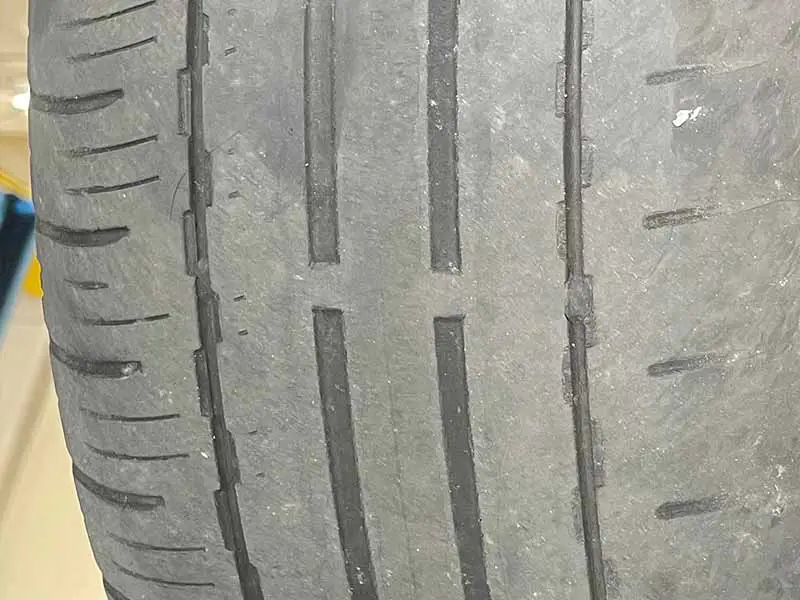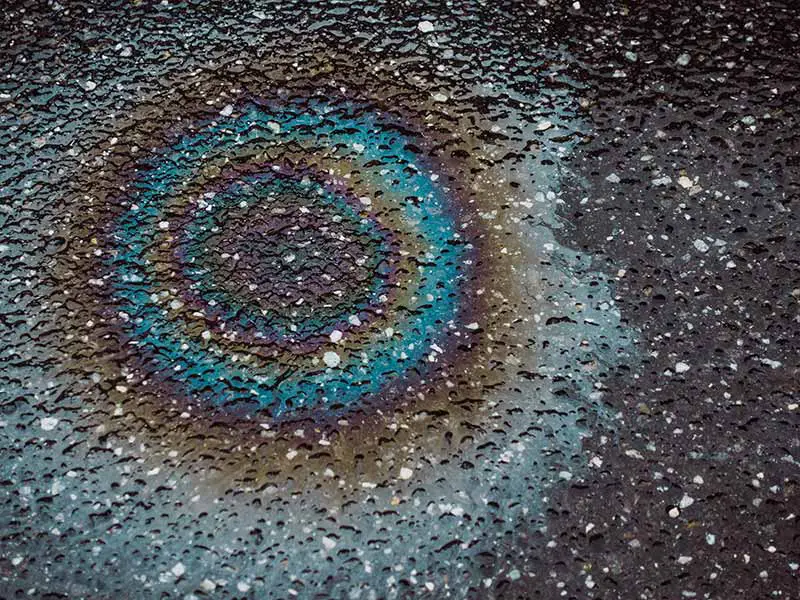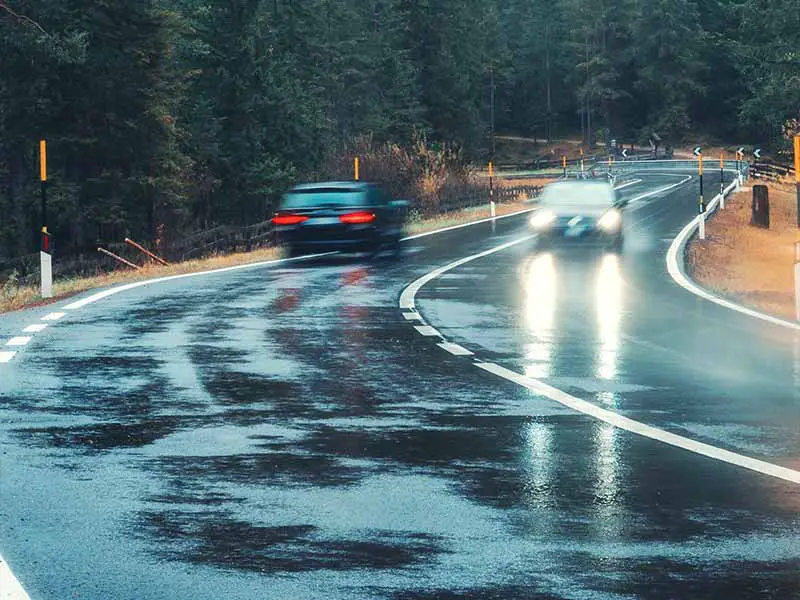It can be unsettling when you’re trying to make your way in a rainstorm and your tires are struggling to find traction.
Hard braking and sharp turns should obviously be avoided on wet roads. But when you’re driving carefully and still have trouble with your tires gripping, the cause is often due to low tread wear or even tires that are completely bald.
Tires Not Gripping In Rainy Conditions
While all tires will lose some grip in wet conditions, worn tires are the most common cause of traction problems on rainy days.
If a tire’s tread depth is 4/32″ stopping distances will be 50% longer.
At 2/32″, stopping distance can stretch to 100% longer and hydroplaning can occur at only 35 mph.
Driving more slowly will help you maintain good contact with the pavement, but that is only solving the symptom and not fixing the root of the problem.
Let’s take a closer look.

Why Do My Tires Spin In The Rain?
Rain creates a lubricant of sorts between your tires and the road surface and all tires will lose some grip. Worn tires make this worse, but it can still happen with new tires or even the best tire tread patterns that improve traction in rain.
The less tread depth your tires have, the more likely they are to lose contact with the road surface in wet conditions.
Why Are Roads Slickest At The Beginning Of Rains
If you’re experiencing more spinning when you accelerate away from a stop, it may simply be due to the slick conditions at the beginning of light rain, or being a bit too aggressive with the accelerator pedal.
Most cars and trucks these days have traction control systems that will engage to slow down a spinning wheel and allow it to reach a speed where it can regain traction.
When a light rain begins, the rain mixes with the oil residue that has built up during the dry period before the rain began and makes for unusually slippery conditions.
After a period of time, the rain and oil mixture is washed away by the continuing rain and traction will actually improve slightly.
Although, wet roads will never provide the same level of grip as dry roads.

What Is Hydroplaning?
One of the most unsettling situations that drivers may experience is when their tires lose contact with the road when driving on wet pavement.
My Car Feels Like It’s Sliding On Ice!
This is a situation called hydroplaning and it can happen with new tires or even the best tread patterns designed for rain, although worn tires make the situation much worse.
Hydroplaning is a situation where the grooves in your tires can’t channel water out from underneath the contact patch of the wheel quickly enough and the tire begins to lift up and ride on a cushion of water.
How To Avoid Hydroplaning
There are several factors that can make it more likely that you’ll experience hydroplaning. By following these tips, you can dramatically reduce the chances of experiencing it.
Slow Down
No matter how well a tire may be designed or new it may be, speed can overpower the tread pattern of the best tires. Reduce speed on wet roads to greatly reduce the risk of hydroplaning.
Avoid Standing Water
Large puddles of standing water can’t be dealt with effectively by even the best tires. The grooves in your tire’s tread pattern are quickly overwhelmed by the large volume of water in puddles.
Steer around these obstacles when you see them or slow down if they can’t be avoided.
Monitor Tread Depths
As tires wear over time from their new tire tread depth of 10/32″ or 11/32″, they lose their ability to channel water out from underneath the contact patch of your tires.
Once your tires have worn down to 4/32″ they will have significantly lost their ability to resist hydroplaning. And once they’ve worn down to the legal minimum of 2/32″ you should stop driving on them and have them replaced immediately.
Also, monitor your tread patterns for uneven wear problems. Tires that are not wearing evenly are not maintaining good contact with the pavement and will find it more difficult to find grip in the rain.
Increase Following Distance
Increasing the distance between you and the vehicle in front of you won’t reduce the chance of hydroplaning.
However, it will greatly reduce the chance of gliding into them if they decide to come to a stop during the period that your car or truck has lost contact with the road and is uncontrollable.
Giving yourself more room to maneuver during heavy rain is always a wise move.
Maintain Proper Tire Pressure
If the air pressure in your tires is incorrect they will not be in proper contact with the road surface.
Overinflated tires will ride more on the middle of the tread while underinflated tires will ride on the shoulders.
You can find the proper tire pressure located on the tire information sticker in the driver’s door jamb or your owner’s manual.
How To Stop Hydroplaning
Once your car or truck has begun to hydroplane you are along for the ride. The key is to not panic and set yourself up to regain control safely.
Remove Your Foot From The Accelerator
This will prevent wheel spin and better help you regain contact with the road.
Apply Gentle Pressure To The Brake Pedal
Your brakes will be ineffective while hydroplaning, but gentle pressure on the brake pedal will help you to gently slow down once your tires regain contact.
Don’t Overcorrect With The Steering Wheel
Your car or truck will slide in the direction it was traveling and steering will make no difference while you hydroplane. Try to maintain the steering wheel pointed in the direction of travel to prevent a dangerous situation when your tires regain traction.
Try To Keep Moving As You Regain Control
For your safety and the safety of other motorists, you should try to continue gently driving forward at a slower speed.
If you feel you need to pull over after the experience, do so after you have some distance between you and the area where you slid so that you won’t become a hazard other motorists may hydroplane into.
Effects Of Tread Depth On Wet Roads
The height of your tread blocks affects the size of the grooves in your tread pattern. If the grooves are shallow due to the tires being worn they will not be able to efficiently move water out from under and away from the contact patch of your tire.
Excessive speed can cause your vehicle to hydroplane no matter how good your tires are. But poor tread wear will make the situation far worse.
How Do Bald Tires Affect Braking Distance?
New tires have tread that is 10/32″ to 11/32″ tall which provides deep grooves for water to flow.
Once tires wear down to 4/32″ of tread, you should consider replacing them soon since the majority of the tread has been used and stopping distance on wet surfaces will be 50% greater than when the tires were new.
Tires that have worn down to 2/32″ are at the legal minimum for most states and should be replaced immediately. Driving on tires with this little amount of tread extends stopping distances on wet roads to twice the distance of new tires or more.
Can Bald Tires Cause Traction Control?
It’s not uncommon to notice the traction control light on when raining and your tires have little tread remaining. This is a common sign that your tires are bald or are very close to being so.
Aggressive driving in rainy conditions can lead to the traction control light being triggered, but if that isn’t your situation you should check your tire’s wear bars or use the penny test to see if you need to purchase new tires.
How Much Slower Should You Drive In The Rain?
Many people drive beyond the speed limit so I won’t get into the legalities of this. But if you are driving in slippery conditions you should slow down to the speed limit at a minimum. If your experiencing heavy rain you should consider slowing down even further.
Speed is the number one cause of hydroplaning and loss of traction in wet weather conditions. Reducing speed can make a huge difference in how well your tires can maintain contact with the pavement and keep you in control.
Resources
Below are some links you may find helpful when learning about tires
- Tires don’t have to be worn out to lose traction in wet weather, study shows – Consumer Reports
- Avoid hydroplaning through tire and driver education – Bridgestone
Final Thoughts
Tread depth is critical to safety in rainy weather to maintain reasonable stopping distances and reduce the chances of hydroplaning.
If you find your wheels spinning or your vehicle sliding around, check the depth of the tread remaining on your tires and consider replacing them if it is worn down to 4/32″ or replace them immediately if they’ve worn down to 2/32″.
If this isn’t the issue you may need to check the air pressure in your tires or sources for uneven tire wear such as alignment problems.
Good luck and happy motoring.





